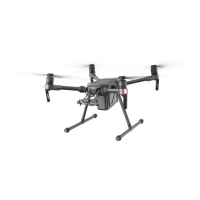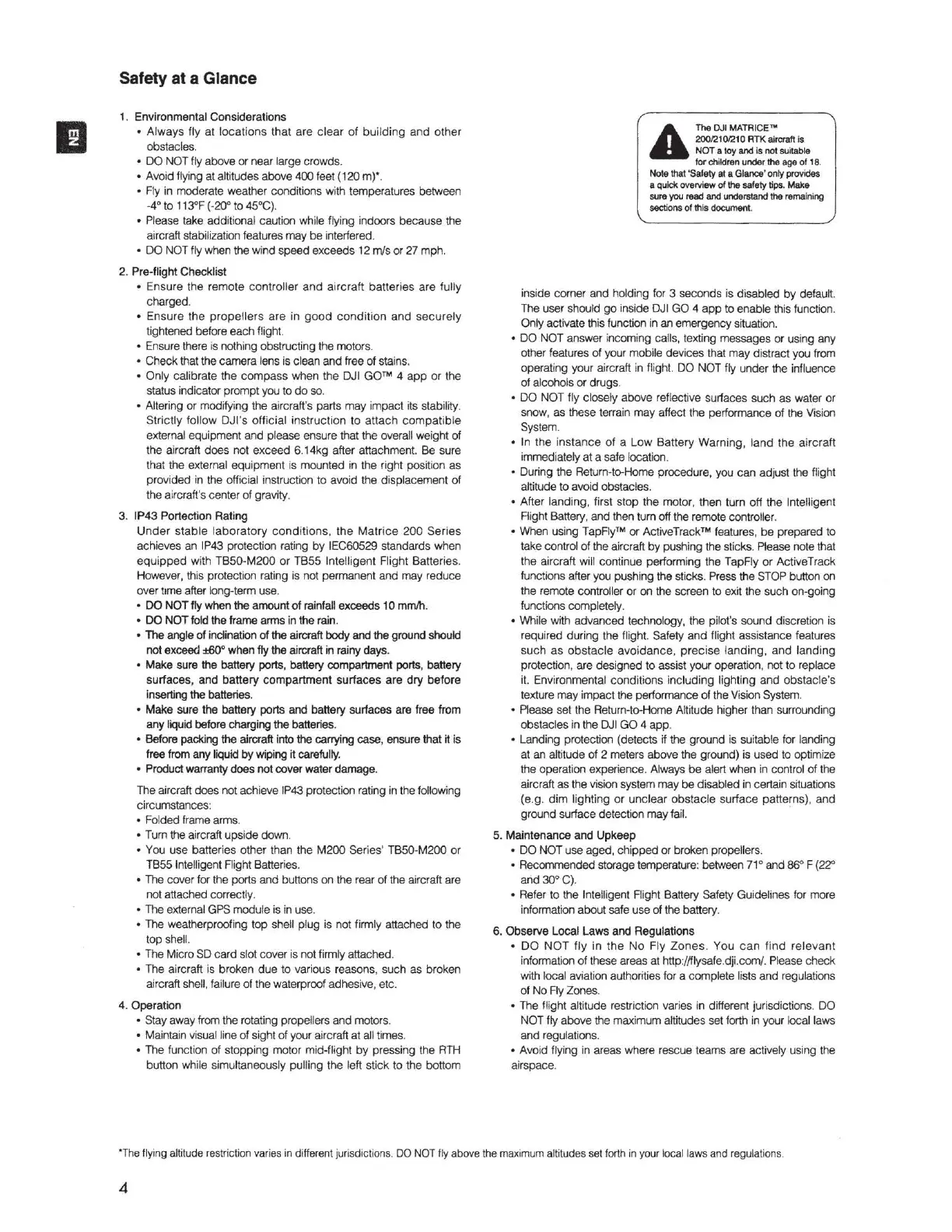•
Safety
at
a Glance
1. Environmental
Considerations
•
Always
fly
at
locations
that
are
clear
of
building
and
other
obstacles.
•
DO
NOT
fly
above
or
near large crowds.
•
Avoid
flying
at
altitudes
above
400
feet (120
m)*
.
• Fly
in
moderate
weather
conditions with temperatures between
-4°
to
113°F (-20°
to
45
°C).
• Please take additional caution while flying indoors
because
the
aircraft stabilization features
may
be
interfered.
•
DO
NOT fly
when
the
wind
speed
exceeds
12
m/s
or
27
mph.
2. Pre-flight
Checklist
•
Ensure
the
remote
controller
and
aircraft
batteries
are
fully
charged.
•
Ensure
the
propellers
are
in
good
condition
and
securely
tightened before
each
flight.
• Ensure there is nothing obstructing the motors.
•
Check
that
the
camera
lens is clean
and
free of stains.
•
Only
calibrate
the
compass
when
the
OJI
GO™
4
app
or
the
status indicator
prompt
you
to
do
so.
• Altering
or
modifying
the
aircraft's
parts
may
impact
its stability.
Strictly
follow
DJl's
official
instruction
to
attach
compatible
external equipment
and
please ensure that
the
overall weight
of
the aircraft
does
not
exceed
6.14kg
after
attachment.
Be
sure
that
the
external
equipment
is
mounted
in
the
right
position
as
provided
in the official
ins
truct
i
on
to
avoid the
displacement
of
the
aircraft's center
of
gravity.
3.
IP43
Portection Rating
Under
stable
labo
ratory
conditions,
the
Matrice
200
Series
achieves an IP43 protection rating
by
IEC60529 standards
when
equipped
with
T850-M200
or
TB55
Intelligent
Flight
Batteries
.
However, this protection rating is
not
permanent
and
may
reduce
over
time
after long-term use.
•
DO
NOT
fly
when
the amount
of
rainfall exceeds 1 O mmlh.
•
DO
NOT
fold the frame arms in the rain.
•
The
angle
of
inclination
of
the aircraft
body
and
the ground should
not
exceed :t60° when fly the aircraft
in
rainy days.
•
Make
sure the battery ports, battery compartment ports, battery
surfaces,
and
battery
compartment
surfaces
are
dry
before
inserting
the
batteries.
•
Make
sure
the
battery ports
and
battery surfaces
are
free
from
any
liquid before charging the batteries.
• Before packing the aircraft
into
the
carrying case, ensure
that
it
is
free from
any
liquid
by
wiping
it
carefully.
• Product warranty
does
not
cover
water
damage.
The aircraft
does
not
achieve IP43 protection rating in
the
following
circumstances:
• Folded frame arms.
• Turn the aircraft
upside
down.
• You
use
batteries
other
than
the
M200
Series'
TB50
-
M200
or
TB55
Intelligent Flight Batteries.
• The cover for the
ports
and
buttons
on
the rear
of
the aircraft
are
not
attached correctly.
• The external GPS
module
is in use.
• The weatherproofing
top
shell
plug
is
not
firmly attached
to
the
top
shell.
• The
Micro
SD
card
slot
cover
is
not
firmly attached.
• The aircraft is
broken
due
to
various reasons,
such
as
broken
aircraft shell, failure
of
the waterproof adhesive,
etc
.
4.
Operation
• Stay
away
from
the
rotating propellers
and
motors.
• Maintain visual line
of
sight
of
your aircra
ft
at
all
times
.
• The function
of
stopping
motor mid-flight
by
pressing
the
RTH
button
while
simultaneously
pulling
the
left
stick
to
the
bottom
A
The
DJI
MATRICEN
200/210/21
O RTK aircraft is
NOT a loy and is not suitable
for children under the
age
of
18.
Note
that 'Safety at a Glance' only provides
a
quid<
oveoview
of the safety tips.
Make
sure you read and understand the remaining
sections
of this
document.
inside
corner
and
holding
for 3
seconds
is
disabled
by
default.
The user should
go
inside OJI
GO
4
app
to
enable
this function.
Only
activate this function in
an
emergency
situation.
•
DO
NOT
answer i
ncoming
calls, texting messages
or
using
any
other features
of
your
mobile
devices that
may
distract
you
from
operating your aircraft in flight.
DO
NOT
fly
under
the
influence
of
alcohols
or
drugs
.
•
DO
NOT
fly
close
ly
above
reflective surfaces
such
as
water
or
snow,
as
these terrain
may
affect
the
performance
of
the Vision
System.
•
In
the
i
nstance
of
a
Low
Battery
Warning,
land
the
aircraft
immediately
at
a safe location.
• During
the
Return-to-Home
procedure
,
you
can
adjust the flight
altitude
to
avoid
obstacles.
• After
landing,
first
stop
the
motor, then turn
off
the
Intelligent
Flight Battery,
and
then turn off
the
remote controller.
• When using TapFly™
or
ActiveTrack™ features,
be
prepared
to
take
control
of
the aircraft
by
pushing
the
sticks. Please note
that
the aircraft will
continue
performing
the
Tap
Fly
or
Active
T
rac
k
functions after
you
pushing
the sticks. Press the STOP button
on
the
remote controller
or
on
the screen to exit the
such
on-going
functions completely.
• While
with
advanced
technology,
the
pilot's
sound
discret
ion
is
required
during
the flight. Safety
and
flight assistance features
such
as
obstacle
avo
i
dance,
precise
landing,
and
landing
protection, are
designed
to
assist your operation,
not
to
replace
it.
Env
ironme
ntal
conditions
including
lighting
and
obstacle's
texture
may
impact
the performance
of
the Vision System.
• Please
set
the Return-to-Home Altitude higher than surrounding
obstacles
in
the
OJI
GO
4
app
.
• Landing protection (
detects
if the
ground
is suitable for landing
at
an
altitude
of
2 meters
above
the ground)
is
used
to
optimize
the operation experience. Always be alert
when
in control
of
the
aircraft
as
the vision system
may
be d
isa
bled
in certain situations
(e.g.
dim
lighting
or
unclear
obstacle
surface
patterns),
and
ground
surface detection
may
fail. ·
5.
Maintenance
and
Upkeep
•
DO
NOT
use
aged,
c
hipped
or
broken propellers.
• Recommended storage temperature: between
71
°
and
86° F (22°
and
30°C).
• Refer
to
the Intelligent Flight Battery Safety Guidelines for
more
information
about
safe use
of
the battery.
6.
Observe
Local
Laws
and
Regulations
•
DO
NOT
fly
in
the
No
F
ly
Zones.
You
can
f
ind
relevant
information
of
these areas
at
http://flysa
fe
.dji.com/. Please
check
with local aviation authorities for a complete lists
and
regulations
of
No
Fly Zones.
•
The
flight altitude restriction varies in different jurisdictions.
DO
NOT
fly
above
the maximum altit
udes
set forth in your local laws
and
regulations.
•
Avoid
flying in areas
where
rescue
teams
are actively using the
airspace.
"The flying altitude restriction varies in different jurisdictions. DO NOT fly above the maximum altitudes set forth in your local laws and regulations.
4

